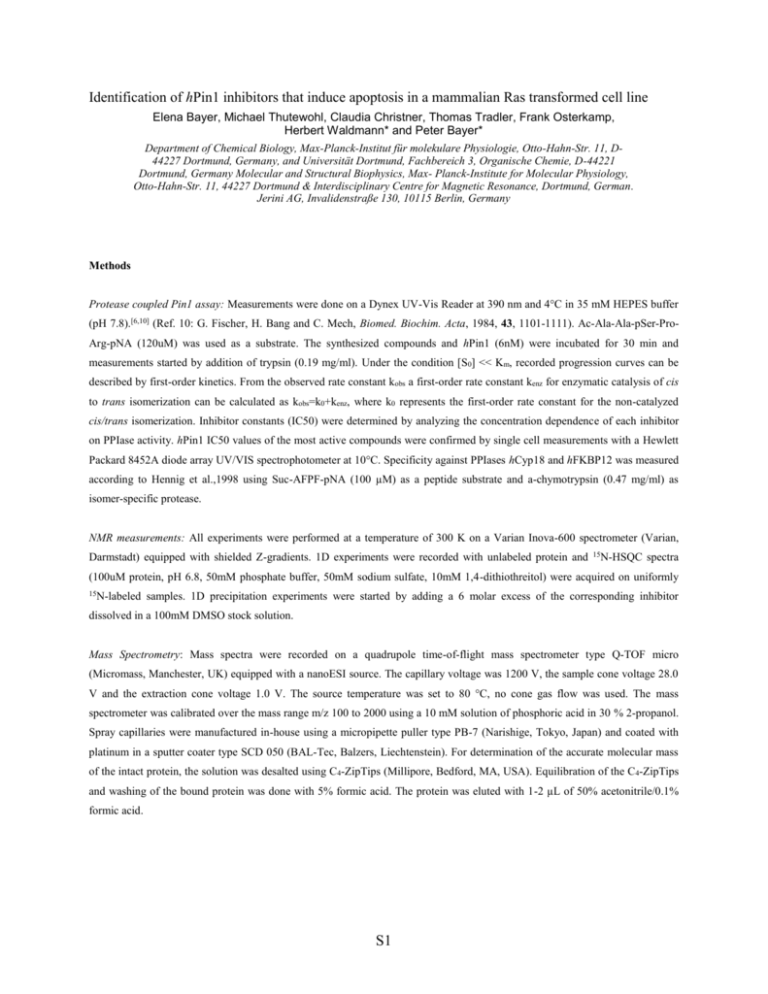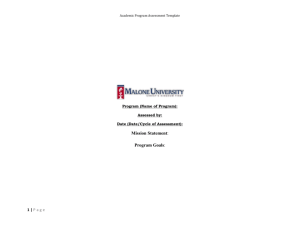Precipitation data, TOF-MS-ES + spectra, methods and peptidic
advertisement

Identification of hPin1 inhibitors that induce apoptosis in a mammalian Ras transformed cell line Elena Bayer, Michael Thutewohl, Claudia Christner, Thomas Tradler, Frank Osterkamp, Herbert Waldmann* and Peter Bayer* Department of Chemical Biology, Max-Planck-Institut für molekulare Physiologie, Otto-Hahn-Str. 11, D44227 Dortmund, Germany, and Universität Dortmund, Fachbereich 3, Organische Chemie, D-44221 Dortmund, Germany Molecular and Structural Biophysics, Max- Planck-Institute for Molecular Physiology, Otto-Hahn-Str. 11, 44227 Dortmund & Interdisciplinary Centre for Magnetic Resonance, Dortmund, German. Jerini AG, Invalidenstraße 130, 10115 Berlin, Germany Methods Protease coupled Pin1 assay: Measurements were done on a Dynex UV-Vis Reader at 390 nm and 4°C in 35 mM HEPES buffer (pH 7.8).[6,10] (Ref. 10: G. Fischer, H. Bang and C. Mech, Biomed. Biochim. Acta, 1984, 43, 1101-1111). Ac-Ala-Ala-pSer-ProArg-pNA (120uM) was used as a substrate. The synthesized compounds and hPin1 (6nM) were incubated for 30 min and measurements started by addition of trypsin (0.19 mg/ml). Under the condition [S0] << Km, recorded progression curves can be described by first-order kinetics. From the observed rate constant kobs a first-order rate constant kenz for enzymatic catalysis of cis to trans isomerization can be calculated as kobs=k0+kenz, where k0 represents the first-order rate constant for the non-catalyzed cis/trans isomerization. Inhibitor constants (IC50) were determined by analyzing the concentration dependence of each inhibitor on PPIase activity. hPin1 IC50 values of the most active compounds were confirmed by single cell measurements with a Hewlett Packard 8452A diode array UV/VIS spectrophotometer at 10°C. Specificity against PPIases hCyp18 and hFKBP12 was measured according to Hennig et al.,1998 using Suc-AFPF-pNA (100 µM) as a peptide substrate and a-chymotrypsin (0.47 mg/ml) as isomer-specific protease. NMR measurements: All experiments were performed at a temperature of 300 K on a Varian Inova-600 spectrometer (Varian, Darmstadt) equipped with shielded Z-gradients. 1D experiments were recorded with unlabeled protein and 15N-HSQC spectra (100uM protein, pH 6.8, 50mM phosphate buffer, 50mM sodium sulfate, 10mM 1,4-dithiothreitol) were acquired on uniformly 15N-labeled samples. 1D precipitation experiments were started by adding a 6 molar excess of the corresponding inhibitor dissolved in a 100mM DMSO stock solution. Mass Spectrometry: Mass spectra were recorded on a quadrupole time-of-flight mass spectrometer type Q-TOF micro (Micromass, Manchester, UK) equipped with a nanoESI source. The capillary voltage was 1200 V, the sample cone voltage 28.0 V and the extraction cone voltage 1.0 V. The source temperature was set to 80 °C, no cone gas flow was used. The mass spectrometer was calibrated over the mass range m/z 100 to 2000 using a 10 mM solution of phosphoric acid in 30 % 2-propanol. Spray capillaries were manufactured in-house using a micropipette puller type PB-7 (Narishige, Tokyo, Japan) and coated with platinum in a sputter coater type SCD 050 (BAL-Tec, Balzers, Liechtenstein). For determination of the accurate molecular mass of the intact protein, the solution was desalted using C4-ZipTips (Millipore, Bedford, MA, USA). Equilibration of the C 4-ZipTips and washing of the bound protein was done with 5% formic acid. The protein was eluted with 1-2 µL of 50% acetonitrile/0.1% formic acid. S1 S2 Figure 3: A, NMR tubes showing precipitation of a 100M hPin1 solution. Left, control (addition of 3l of a 100mM DMSO solution), middle, 6-fold molar excess of compound 1, right, 6-fold molar excess of juglone. B, SDS gel under reducing conditions. S, supernatant, MW, molecular weight marker, P, precipitate. Figure 4: TOF MS ES+ spectra of juglone-treated and untreated wild type Pin1. A, wild type Pin1 (exp. molecular mass 18108 Da). B, wild type Pin1 treated with a 5-fold molar excess of juglone. Recorded mass spectra revealed new signals representing molecular masses of Pin1 modified by 2,3,4,5,6 (exp. 18452.5, 18625.0, 18813.5, 18985.6, 19175.5 Da, respectively) and more juglone (J) molecules. To avoid detection of noncovalent Pin1/juglone adducts, any loosely bound juglone was removed by C4 chromatography of the protein prior to analysis. Tables 1-3: Compounds investigated as possible Pin1 inhibitors. Inhibitors, leading to apoptosis of a Ras-transformed MDCK-f3 cell line, are labelled with bold letters, inhibitors of Pin1 presented in figure 1 are additionally underlined. Numbers in brackets refer to the original published compound numbers9b. Table 1: HO 1 R Me N HN O O MeO S3 O N Me Y O R2 R1 Entry R2 O O 1 NH N H S O 2 O N 3 (21) -OH 4 (20/2) 5 (20/3) 6 (20/4) -OH -OH -OH O 7 -OH O 8 -OH OMe O 9 O OH O 10 O Table 2: OH R2 1 R 3 R * HN O N OH N H O O O 4 R entry R1 R2 S4 * R3 R4 1 O D Me H D D L L L L D D H H H H H Me Me H H OH OH H H H H H D H H D H H L L D D H Me Me H H H H H D H H D H H D H H D Me H D H H HOPh=i 2 3 4 5 6 7 8 HOPhHOPhHOPhPhImid Imid Imid i i i i i i i O 9 Imid O2N 10 Imid 11 = ii ii ii ii 12 13 14 15 Imid Imid Imid Imid Imid 16 Imid 17 Imid 18 Imid 19 Imid 20 ortho Imid BnO 21 22 =o ortho o meta o Imid Imid L L H H H H 23 para o Imid D H H N HN Imid HO HOPh- S5 Ph- Table 3: R2 R1 HN R4 R3 * O N OH N O O 3 R O HO entry R1 R2 1 * R3 R4 D H Ph D H Naph HOPh- 2 (45) HOPh- S6






